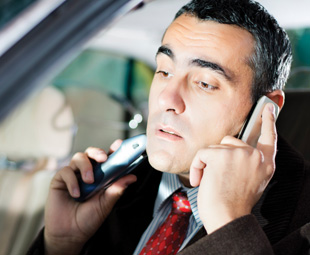So you think you can drive?

The Automobile Association (AA) recently proved the dangers of distracted driving
We motoring journalists like to think we can drive well. Writing about the automobile industry all day means we even get to drive some nice machinery every now and then. Further still, we’re passionate about all things wheeled; so take seriously the ability to control whatever bike, car or truck we find ourselves in command of, with a deft and precise hand.
Those of us who are members of the South African Guild of Motoring Journalists are required to pass all manner of defensive and advanced driving courses. Theoretically, at least, we are well aware of poor driving habits and the trouble they can create.
It doesn’t matter who you are, or what vehicle you’re driving, if you aren’t paying full attention your chances of being involved in an accident are drastically increased. The AA wanted to prove this, and recently invited a number of journalists to get behind the wheels of some of its driving simulators.
Once comfortable with the simulators, the journalists were sent around a virtual racetrack to set some times. These averaged around one minute, 41 seconds per lap. Then typical distractions were thrown at them: they were sent SMS messages to which they were required to respond, were asked to open and close a water bottle and were also distracted by being engaged in simple conversation.
The results? An average lap time of two minutes, 20 seconds with many cars spiralling out of control or crashing.
OK, it’s not the most scientific experiment – but it does prove a very important point.
“Drivers who are distracted need to realise that their actions are not only irresponsible, but also put the lives of other, law-abiding citizens in jeopardy. Their own reckless behaviour can cause a crash that injures or kills other people. We also want to make these drivers aware that it can happen to them: no-one is immune to the dangers of being distracted,” the AA says.
So, are you or those driving your vehicles distracted? These are among the most prevalent distractions when driving: talking on cellphones or texting; eating; putting on ties or other clothing, or even changing clothes; applying makeup; looking to the back seat to engage passengers; setting GPS devices while moving; and searching for items in various areas of the car.
Avoiding these issues is a simple matter. Turn your phone to silent when you get in the car – or even put it in the boot if you just can’t resist the urge to use it while on the move. Set the destination on your GPS before embarking on a journey.
If you absolutely can’t resist the urge to change clothes or apply makeup in the car, make sure you do it while parked with the engine off … Better still, just do these things at home …
The AA urges drivers who engage in any of these activities while behind the wheel to change their attitude and take responsibility for their actions.
I fully agree … Getting dressed while driving? I mean, have you ever!
Published by
Focus on Transport
focusmagsa




 Big news from FOCUS on Transport + Logist
Big news from FOCUS on Transport + Logist


 !
Starting 1 April, every
!
Starting 1 April, every


 FUSO: Driving the Future of Mobile Healthc
FUSO: Driving the Future of Mobile Healthc



 A brand
A brand




 Wondering about the maximum legal load for a
Wondering about the maximum legal load for a 
 The MAN hTGX powered by a hydrogen combus
The MAN hTGX powered by a hydrogen combus

 Exciting News for South African Operators
Exciting News for South African Operators


